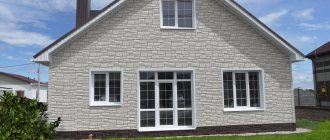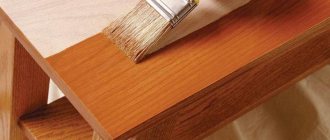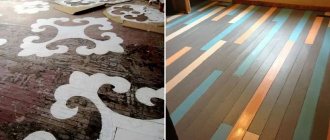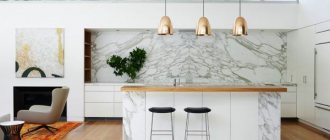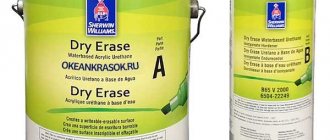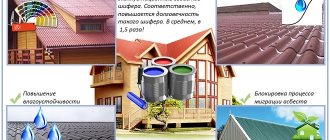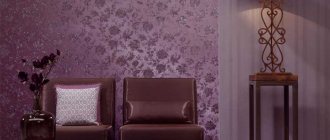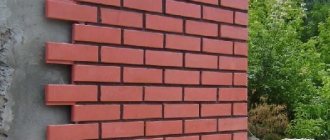Plywood is considered a popular material for decoration, as well as for furniture production. Demand for it is growing due to its low cost, and the material itself consists of several thin sheets of veneer glued together. When carrying out repair work, painting of plywood is often required: in order to do this efficiently, you need to familiarize yourself with the sequence of the procedure, as well as choose the right paint composition.
Painting plywood
Preparing the surface for painting
Plywood panels are an environmentally friendly and affordable material, so they can be used in any area for repairs. Before you paint plywood, you need to properly process it yourself. Then the adhesion of the material to the coating will improve, and the paint and varnish composition will lie beautifully and evenly.
Raw materials are often sold in this form in warehouses: they may or may not be polished. Depending on this, a list of preparatory work for painting is determined.
The entire technology for preparing a product for painting consists of processing the material: cleaning and sanding it, as well as priming and puttying.
Primer for plywood
Features of plywood
Plywood is one of the most popular building materials, which has a number of undeniable advantages. Most often it is used for some rough work, but this material is perfectly suited for ceiling decoration:
- First of all, one cannot fail to note the low cost. Those who are undertaking renovations know how much it can cost. Therefore, they try to save wisely wherever possible.
- Great appearance. Of course, ordinary plywood cannot compete with more expensive finishing materials. But as soon as you cover it with several layers of varnish or stain, it instantly transforms. Therefore, it can easily replace natural wood ceiling panels. More modern plywood is covered with a film that imitates natural material. There are many different designs on the market that will fit perfectly into your interior!
OSB is a compressed particle board with oriented flat chips
- Simplicity and ease of installation. Even one person can make a ceiling out of plywood. The only difficulty that may arise is the need to support the material during installation. Even a beginner can decorate his home this way!
- If you want to add recessed lighting to your interior, a plywood ceiling is ideal for this, just like plasterboard.
Despite all the advantages, it is also worth discussing the possible disadvantages of this material.
It can hardly be considered natural. Still, its production uses a large number of chemical components and resins. Of course, they are not harmful to human health.
However, there is plywood with increased resistance to moisture. Its production uses formaldehyde, which may pose some danger. Therefore, it is better not to use it for finishing.
Cleaning and sanding the material
When purchasing raw materials, you should pay attention to its texture: if it is very rough, the material must be cleaned and sanded. Before painting the plywood yourself, experts recommend drying it. Most likely, the sheets of material were sold from a warehouse, and it was often humid and damp there, so the wood could absorb some of the moisture. It is not possible to dry the product quickly, so the sheets of material are sent to a dry and warm place for 3 days.
With this tool you can sand small surfaces. If the sheets of material are large, it is better to use a power tool.
Once the plywood has dried, you can begin preparing it:
- Cleaning. This simple process is carried out to ensure that no large specks or contaminants remain on the surface of the raw material. Plywood can absorb moisture, so do not use water when cleaning. High-quality wood will always have a distinctive pattern - you also need to walk over it and check for contamination. Dirt must be removed using a coarse brush.
- Sanding. This procedure requires perseverance and care. Sanding consists of two stages: the first involves sanding with coarse-grain sandpaper, and the second with fine-grain sandpaper. The important thing here is to achieve not beauty, but a smooth surface. According to the advice of the masters, it is better to use a special grinding machine - this will speed up the work.
After passing coarse grain across the surface, it is necessary to change the nozzle to paper with fine dispersion. This procedure can easily be carried out manually, but it will take more time. Don't forget about the edges of the product - they also need to be cleaned and sanded.
Varnishing plywood
Painting materials
Pigments
Plywood is a material that is glued together from several sheets of natural wood veneer. Due to its properties, as well as its low price and ease of processing, it is widely used in construction and finishing works.
One of the disadvantages of plywood is its vulnerability to external influences, primarily to precipitation and water condensing on the skin from the air.
That is why craftsmen have to decide how to paint plywood against moisture in such a way as to preserve the material and impart aesthetic properties.
Can be treated with façade and interior wood paints
- For interior finishing work, you can use various water-based paints . These are, first of all, acrylic and latex pigments. After a little preparation (we will provide instructions in the corresponding section), the panels can be painted with such compositions without compromising quality.
Advice! When deciding how to paint plywood on the ceiling or walls, you should give preference to materials with high elasticity, since they do not crack under intense thermal deformation of the wood.
- Enamel (pentaphthalic) paints for wood are also suitable for interior work . They are easy to apply, penetrate deeply between the fibers and dry relatively quickly.
- If you are interested in how to paint plywood outdoors, then the task becomes more complicated . Experts recommend thoroughly saturating all the slabs with drying oil, and then applying red lead to them. Alkyd-based enamel can already be applied over the red lead layer.
- An alternative can be special impregnations based on oils or varnishes with tinting components . In principle, these are not exactly paints, but they do an excellent job of protecting and decorating.
Using varnish-based impregnation
Note! The price of a composition for wood largely depends on the quality. It is better to spend money once on products from a world-famous manufacturer than to restore the finish every two or three years, and completely change the plywood every ten years.
Auxiliary materials
In addition to the pigments themselves, we will need other means.
For example, when thinking about how to paint plywood on a wall, you should also buy:
- Wood putty, which will be used to level the base for painting.
- A polymer-based primer that provides penetration into the thickness of the fibers and imparts the necessary adhesion.
- Protective varnishes that can be applied over paint. Most often, varnishing is used when laying plywood on the floor, but wall cladding can also be treated.
Primer with antiseptic properties
The use of a complex of materials will allow you to achieve a much better result than simply painting on a sanded plywood board.
Surface priming and puttying
The next two stages of preparing plywood for paint treatment are priming and puttying. It is necessary to paint plywood with a primer in order to fill all existing voids on the surface: this will prevent further cracking of the material. Before applying the composition, degreasing is carried out so that no extra pieces of wood remain on the material. It is necessary to prime the plywood in 3-4 layers. When further painting it in a transparent color, the craftsmen recommend additionally applying several layers of antiseptic and fire retardant on top of the primer - they will protect the product from fire and prevent it from turning blue.
Priming can be done using a small brush and a pre-selected primer material.
It is necessary to cover the plywood with a new layer of primer only after the previous layer has completely dried. This work may take several days. When the priming procedures are completed, it is recommended to thoroughly dry the material again. The correct technology for preparing for painting contains one more step - puttying. Plywood especially needs additional protection, and it is the putty that will protect the coating from mechanical damage in the future.
Sanding plywood
The process looks like this:
- White acrylic putty is used for work. Due to the fact that plywood is often used to level various types of surfaces (floor, ceiling or walls), mechanical protection will not be superfluous. It is the acrylic base that makes the plywood moisture resistant, which makes it possible to use it in damp rooms by attaching it to a slatted frame.
- Tools and application. To work you need a spatula and a rule. The putty is applied in small strokes, after which the layer is usually leveled. The optimal coating thickness is 2-3 mm, with special attention should be paid to joints and recesses.
At the priming stage, before filling, you can apply a stain to the surface of the material - this will also additionally protect it.
Spray painting
Preparation and varnishing of plywood
Only sanded plywood can be varnished, which can be ordered inexpensively from us. If you have unsanded sheets, you need to sand them first. Before varnishing, the surface of the material should be cleaned of debris and treated with a primer - this way you will get the most durable and durable coating .
You can apply varnish:
- brush;
- roller;
- spatula;
- spray gun;
- tampon (a ball of cotton wool wrapped in cotton fabric).
Using a spray gun, the most uniform and thin coating is obtained. The same effect can be achieved by painting with a tampon. But the manual varnishing method is inferior in speed. Therefore, it is only suitable for applying varnishes that take a long time to dry. With a brush the coating will be thicker and uneven. A spatula will ensure a thick layer and an even layer. The roller will not be able to paint over small irregularities.
Choosing paint or varnish for plywood
When choosing what to paint plywood for decoration or finishing, it is recommended to pay attention to the subsequent conditions of its use. If the material will be used outdoors, it is better to choose oil-based compounds and waterproof varnish. When using the material indoors, acrylic or water-based paint is suitable. Depending on the final result, you can use either an aerosol can or a spray gun. If you need to make an inscription, then an airbrush is good.
Some tips for choosing paint:
- You can use oil-based enamel to paint external plywood slabs (this option is suitable for a summer house);
- Water-based paint can be used to cover the outside of houses, and this option can also be used to decorate furniture, since the composition is odorless;
- acrylic composition is good for painting plywood toys, children's crafts, doll houses, as well as decorating items for the interior;
- enamels, for example, PF-115, are made on the basis of pentaphthalic varnish; they are suitable for plywood that will be used in places with frequent temperature changes.
Coating the material with varnish is one of the most important steps in preventing mechanical damage.
The choice of varnish also has its secrets. For example, if you want to paint laminated plywood, giving it a wooden texture, powder dye is poured into the varnish: when applied to the surface, an interesting pattern is created. Transparent gloss varnish is best used when you plan to decorate plywood while maintaining the original appearance. The enamel composition must be used when the product is planned to be used continuously.
Correct coloring of plywood
When calculating how long it will take to complete the entire process of working with plywood, it is also worth considering its markings. When purchasing, it is worth checking the letter assigned to the material and its grade - this will help to avoid large amounts of time spent on preparation.
Painting process
The compounds are applied in a thin layer, avoiding drips and streaks.
Painting plywood is not difficult. It is important to follow the recommendations.
- For large areas, it is better to take a spray gun. If the surface to be painted is small, use brushes or rollers.
- Dilute the paint immediately before the procedure. If the composition dries quickly, make a minimum portion.
- Apply any paints and varnishes only along the wood fibers.
- If a more intense shade is required, apply in several layers, waiting for the previous one to dry.
You cannot apply a thick layer at once: the paint will harden unevenly, flow, and bubbles will form.
How to coat correctly
The stain is applied by rubbing.
There are several options for applying paintwork. The method is chosen depending on the viscosity and hiding power of the composition.
- It is better to apply stains with wax or oil mixtures by rubbing. A portion of the composition is poured onto the surface and carefully distributed with a sponge or roller.
- It is best to apply paint from a can. This way you get a very even thin layer.
- A foam roller is used when applying liquid compositions of low coverage. This allows you to avoid divorces.
- Thick paints and stains are applied with a paint brush to obtain a rich shade and emphasize the structure.
If oil stain is applied in several layers, after the first has dried, you need to sand the surface to remove any raised lint.
Wood imitation
Plywood products can be given the appearance of noble antiquity. There are a lot of methods. The simplest involves using a candle .
- Paint the sheet with the chosen color, apply strokes randomly in different directions.
- After drying, use a paraffin candle to wipe the sheet in the same way - in random or selected places.
- Apply a second layer of paint - a matching or contrasting shade. The plywood is covered evenly.
- While the paint is not dry, wipe the layer with a rag. In areas where there was wax, it is easily erased, in others it remains.
You can apply a third layer of paint or, after drying, varnish the plywood. It turns out to be a very interesting structure.
Features of painting white
Even with high hiding power of paint, it is difficult to obtain a pure white color . Plywood is prepared for this: primed with white mixtures and sanded. Matte paints are used for coating , since glossy ones do not hide, but highlight the slightest surface and color defects.
Drying
Drying plywood is a preliminary stage of work. This is done if you need to paint or varnish material brought from the cold. The sheets are placed in the room where they will be used and kept for about a day. If the material was stored or transported at a temperature difference of more than 10–15°C, it will take 3 days.
Painted plywood dries naturally. Hairdryer is not used .


